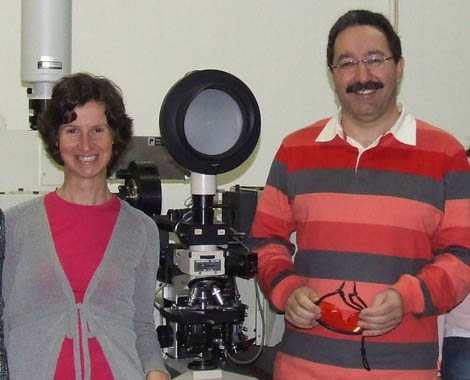 International research led by the University of Coimbra takes a decisive step to reduce resistance to a drug used to combat various types of cancer.
International research led by the University of Coimbra takes a decisive step to reduce resistance to a drug used to combat various types of cancer.
An experiment carried out by a team of researchers from the University of Coimbra (UC), at the ISIS Research Center – which produces the most powerful neutron and muon beam in the world – based at the Rutherford Appleton Laboratory (RAL) of the Science and Technology Facilities Council, near Oxford, UK, allowed a better understanding of how glutathione (cellular antioxidant) contributes to acquired resistance to cisplatin, a drug widely applied in the treatment of various types of cancer (lung, testicle, ovary and bladder, among others ).
At the same time, the international team led by Maria Paula Marques and Luís Batista de Carvalho, from the R&D Unit “Molecular Physical Chemistry” of the Faculty of Science and Technology of the University of Coimbra (FCTUC), also managed to “mask” the drug with a a vehicle based on cyclodextrin (sugar polymer) to prevent its contact with glutathione and thus effectively make it reach the tumor where it will exert its therapeutic effect.
The highly promising results achieved in these experiments, which were highlighted on the official ISIS page – science “highlight” (http://bit.ly/NQf416), represent a significant step towards overcoming two of the major problems of cisplatin and similar drugs – its high toxicity and the resistance acquired by patients to chemotherapeutic treatment.
Understanding how “glutathione sequesters cisplatin, preventing it from reaching the target in appreciable doses – (only a small percentage of the dose administered to the patient reaches cancer cells) – and finding a way to overcome this type of resistance, will allow the development of formulations more effective and less toxic for the patient», explain Maria Paula Marques and Luís Batista de Carvalho.
In the next few days, researchers will travel to ISIS again to continue the experiments, which will this time aim to verify that the drug (cisplatin and new analogue compounds) encapsulated in cyclodextrins is not affected by glutathione, thus avoiding consumption before reaching the therapeutic target.
If positive results are obtained, it will then be possible to proceed to pre-clinical and clinical trials, in order to test the feasibility of the practical application of these new formulations. “We hope to prove that the cyclodextrin capsule efficiently protects cisplatin, making it a good transporter to the target. If the effectiveness of this strategy is confirmed, this vehicle may also reduce the drug's side effects, as it protects healthy cells from its harmful effects. It may also allow the treatment hitherto administered exclusively intravenously to be done orally, significantly increasing the patient's comfort and quality of life», highlight the researchers.
To reach these results, the experiments carried out at the RAL's ISIS Facility are crucial, as they provide a unique view of drugs at the molecular level, enabling extremely detailed information to be obtained, «which would be impossible with other techniques. It's as if we were observing our samples with a very powerful magnifying glass», illustrates Maria Paula Marques.
The attribution of experience time in this international Laboratory, as well as funding by the European Union, requires the approval of a written application, which is subject to a demanding evaluation process by world academic experts.
Author: Cristina Pinto (Press Office – University of Coimbra)
Science in the Regional Press – Ciência Viva


















Comments